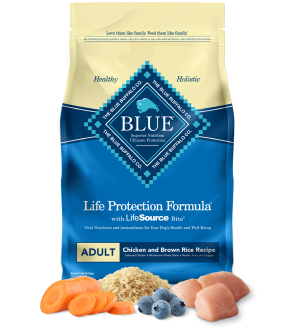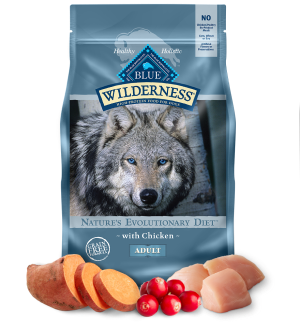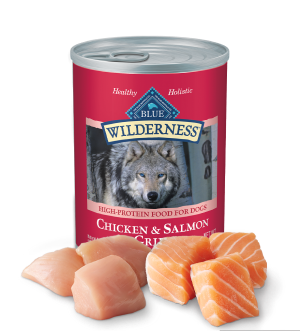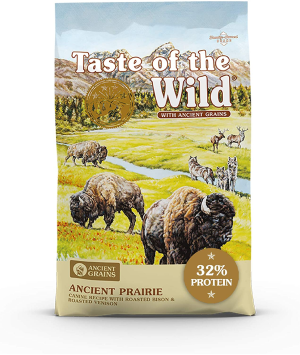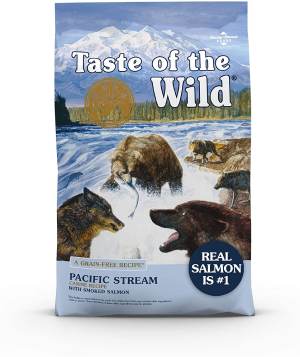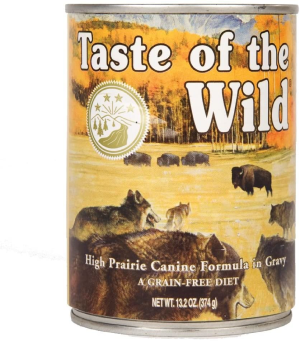You know when people say that you should have a healthy relationship with food? Well, that doesn’t seem logical. You don’t have a relationship with the air you breathe or the clothes you wear, so what makes food so special?
Animals don’t have relationships with food. They eat food to nourish their bodies and get the energy they need to do the things they need to do. And that’s what the best pet food manufacturers get right — providing the most nutritious, natural, and tastiest food.
Many dog food brands fit the bill, so we decided to do a head-to-head for the most popular. In this review, we’ll look at Blue Buffalo vs Taste of the Wild dog food to compare the recipes, nutrition, ingredients, price, and product safety to see which premium dog food brand is the best overall.
Taste of the Wild vs Blue Buffalo — what’s the best for your dog?
About Blue Buffalo Brand
Blue Buffalo has a unique origin story.
The company got started thanks to a dog named Blue. The Bishop family adopted a young pup by the name of Blue, who was their loyal companion for many years until one fateful day that changed the course of their lives.
Blue was diagnosed with cancer.
After heroically battling the illness, Blue died, but the family never forgot their loyal pet and decided to create better dog food. They worked with veterinarians and nutrition experts to come up with natural formulas with complete and balanced nutrition.
“Buffalo” was added to the name to signify a time when buffalo roamed the Great Plains of the US freely — eating only natural food.
When comparing Blue Buffalo vs Taste of the Wild, you’ll see that Blue Buffalo has 250+ dog food products available. They have food for all life stages, breed sizes, and special diet requirements. Blue Buffalo is produced in the USA using natural, globally sourced ingredients.
Blue Buffalo Best-sellers
Blue Buffalo has a massive selection of dog food products and product lines, including grain-free wet and dry food. We chose one dry grain-inclusive, one dry grain-free dog food, and one grain-free wet dog food to compare.
Blue Buffalo Life Protection Formula Adult Chicken & Brown Rice Recipe Dry Dog Food
Deboned chicken is the first ingredient. This recipe includes Calcium, Phosphorus, Omega 3 & 6 Fatty Acids, and Glucosamine. Also has LifeSource Bits mixed in, which are small pieces of kibble that are cold-pressed to prevent nutrients from degrading from heat.
Blue Buffalo Wilderness Chicken Recipe Grain-Free Dry Dog Food
The Wilderness product line is a grain-free alternative with all the benefits of Blue Buffalo, plus more protein (34% compared to 24% in Life Protection Formula). It’s a complete and balanced meal without grains.
Blue Buffalo Wilderness Salmon & Chicken Grill Grain-Free Canned Dog Food
Four out of the first five ingredients are animal protein sources (Chicken, Fish Broth, Chicken Liver, Salmon). It can be served on its own or mixed with dry food. Contains zero grains.
Blue Buffalo Pros
- Excellent variety of dog foods for all life stages, breed sizes, and dietary requirements.
- Produced and distributed in the USA.
- Made with natural ingredients that are globally sourced.
- No chicken (or poultry) by-product meals, which are ground-up chicken bits.
- No corn, wheat, or soy.
Blue Buffalo Cons
- Many product recalls.
Read our full Blue Buffalo Dog Food Review.
About Taste of The Wild Brand
It wouldn’t be fair to compare Blue Buffalo vs Taste of the Wild dog food without the full picture. In case you didn’t know, Taste of the Wild is made by Diamond Pet Foods — a major pet food manufacturer.
Taste of the Wild is made in the USA and is marketed as close to a natural wolf diet. Taste of the Wild produces only 16 varieties of dry food and five wet food options. The food is available in grain-free and grain-inclusive (marketed as Ancient Grains). They’re called ancient grains because the grains used are sorghum, quinoa, millet, and chia seed.
Taste of the Wild is made with high-quality animal protein sources, and most dry foods have 3 out of the first 5 ingredients listed as sources of animal protein. While the quality is there, the variety is lacking, not to mention the lack of recipes for dogs with special nutritional/medical requirements.
Taste of The Wild Best-sellers
Taste of the Wild Ancient Prairie with Ancient Grains Dry Dog Food
Ancient Prairie refers to buffalo meat, which is the #1 ingredient. This recipe includes DHA, Zinc, Selenium, Vitamin A, Vitamin E, L-Carnitine, Taurine, Omega 3 & 6 Fatty Acids, Chondroitin, and Glucosamine. All Taste of the Wild dry dog foods also includes pre- and probiotics for easy digestion.
Taste of the Wild Pacific Stream Grain-Free Dry Dog Food
The grain-free alternative has everything a dog needs to be happy and active. This formula is a balanced mix of proteins (salmon, ocean fish meal), vegetables (potato, peas, tomatoes), fruits (raspberries, blueberries), antioxidants, pre- and probiotics, and other nutrients.
Taste of the Wild High Prairie Canine Recipe with Bison in Gravy
Four out of the first five ingredients are made with animal proteins. This wet food is a gravy, so it’s soupy, and it’s grain-free. Like dry foods, Taste of the Wild canned food is rich in antioxidants and contains no artificial flavors, colors, or preservatives.
Taste of The Wild Pros
- High-quality sources of animal proteins.
- Includes essential nutrients as well as pre- and probiotics for better digestion and digestive health.
- Taste of the Wild PREY product line has limited ingredients, coming as close as possible to a natural wolf diet.
- No wheat, corn, or fillers.
- No artificial colors, flavors, or preservatives.
Taste of The Wild Cons
- Not a lot of variety for breed sizes and no special diet formulas.
Read our full Taste of The Wild Dog Food Review.
Types of Dog Food from Taste of The Wild and Blue Buffalo
|
Product |
Taste of the Wild |
Blue Buffalo |
|
Dry Food |
16 |
97 |
|
Wet Food |
5 |
102 |
|
Treats |
N/A |
55 |
Both brands offer dog foods for all life stages (puppy, adult, senior). However, Blue Buffalo has specialized formulas for seniors, while Taste of the Wild does not have a formula targeting senior dogs (they market adult dog food as senior food).
When it comes to breed size, Blue Buffalo has the upper hand again because they offer kibble for Toy & Small, Standard, and Large breeds. Taste of the Wild only has one dry food for small breeds and nothing for large breeds.
As already mentioned, Taste of the Wild doesn’t have any special diet foods. Blue Buffalo has chicken-free, skin & coat care, digestive care, weight management, and mobility support formulas.
For grain-free diets, both brands have you covered. Blue Buffalo has separate product lines called Wilderness and Freedom that are completely grain-free. Comparing Blue Buffalo Wilderness vs Taste of the Wild, we found that Blue Buffalo is more expensive, however, it has more protein than the Taste of the Wild grain-free options.
Blue Buffalo has Taste of the Wild beat in the variety of recipes due to the sheer amount of product offerings, so to compare Taste of the Wild and Blue Buffalo in this category would be a bit unfair.
Perhaps the lack of options that Taste of the Wild offers for breed sizes and special diets has to do with the “wolf” aspect. In the wild, you get what you can hunt and kill, and no one is going to measure out calories or look at the wolf’s poop to see if it’s too runny.
Winner: Blue Buffalo
Nutritional Value Comparison
Taste of the Wild vs Blue Buffalo dog food nutritional comparison of our top-3 picks
|
Taste of the Wild Ancient Prairie with Ancient Grains Dry Dog Food |
Blue Buffalo Life Protection Formula Adult Chicken & Brown Rice Recipe Dry Dog Food |
||
|
Crude Protein |
32.0% Min |
Crude Protein |
24.0% Min |
|
Crude Fat |
18.0% Min |
Crude Fat |
14.0% Min |
|
Crude Fiber |
3.0% Max |
Crude Fiber |
5.0% Max |
|
Taste of the Wild Pacific Stream Grain-Free Dry Dog Food |
Blue Buffalo Wilderness Chicken Recipe Grain-Free Dry Dog Food |
||
|
Crude Protein |
25.0% Min |
Crude Protein |
34.0% Min |
|
Crude Fat |
15.0% Min |
Crude Fat |
15.0% Min |
|
Crude Fiber |
3.0% Max |
Crude Fiber |
6.0% Max |
|
Taste of the Wild High Prairie Canine Recipe with Bison in Gravy |
Blue Buffalo Wilderness Salmon & Chicken Grill Grain-Free Canned Dog Food |
||
|
Crude Protein |
8.0% Min |
Crude Protein |
10.0% Min |
|
Crude Fat |
3.5% Min |
Crude Fat |
9.5% Min |
|
Crude Fiber |
1.0% Max |
Crude Fiber |
1.5% Max |
It would be wrong to draw conclusions based solely on our top-3 picks, but we looked at the brands’ other offerings and found a trend.
Grain-inclusive Blue Buffalo recipes have less protein than the Taste of the Wild counterparts. While the grain-free options are the opposite — Blue Buffalo has more protein than Taste of the Wild.
We could only compare the grain-free versions for canned foods since Taste of the Wild doesn’t have a grain-inclusive wet food. Blue Buffalo Wilderness has more protein than canned Taste of the Wild.
Winner: Blue Buffalo
Ingredients and Flavors Comparison
The question you’re probably asking yourself is — is Blue Buffalo or Taste of the Wild better when it comes to ingredients and flavors?
As they’re both premium dog food brands, it’s expected that the ingredients and flavors will be top-notch — and they are (with a few slight differences).
Taste of the Wild flavors include:
- Angus Beef
- Bison
- Wild Boar
- Fish
- Fowl (quail, duck, and turkey)
- Lamb
- Venison
Granted, other animal protein sources are used in the ingredients such as Beef, Pork, Chicken, Chicken Liver, Chicken Meal, and others.
Blue Buffalo also uses more “wild” meats, and they include:
- Beef
- Bison
- Chicken
- Duck
- Fish
- Lamb
- Pork
- Red Meat
- Rabbit
- Salmon
- Trout
- Turkey
- Venison
So in the flavor category, Blue Buffalo has more variety, but ingredients are a different story. Taste of the Wild uses “ancient” grains, which are sorghum, millet, quinoa, and chia seed, and Blue Buffalo uses “regular” grains such as brown rice, barley, oatmeal,
Taste of the Wild also wins out with the addition of pre- and probiotics, Glucosamine and Chondroitin (only large breed Blue Buffalo recipes include Chondroitin). Both nutrients are great for joint health and are often included in high-end pet foods.
Winner: Tie (Blue Buffalo wins in flavors, Taste of the Wild wins in ingredients)
Price Comparison
Compare Taste of the Wild to Blue Buffalo prices based on our top-3 picks.
We compared the prices on chewy.com and tractorsupply.com. Depending on when you read this, prices may change or vary.
|
Taste of the Wild Ancient Prairie with Ancient Grains Dry Dog Food |
Blue Buffalo Life Protection Formula Adult Chicken & Brown Rice Recipe Dry Dog Food |
|
Price per pound (28 lb bag): $1.75 |
Price per pound (30 lb bag): $1.66 |
|
Taste of the Wild Pacific Stream Grain-Free Dry Dog Food |
Blue Buffalo Wilderness Chicken Recipe Grain-Free Dry Dog Food |
|
Price per pound (28 lb bag): $1.75 |
Price per pound (24 lb bag): $2.24 |
|
Taste of the Wild High Prairie Canine Recipe with Bison in Gravy |
Blue Buffalo Wilderness Salmon & Chicken Grill Grain-Free Canned Dog Food |
|
Price per 13.2 oz can: $2.29 |
Price per 12.5 oz can: $2.25 |
Taste of the Wild offers both grain-inclusive and grain-free dry dog foods at the same price, which is impressive. Also, their grain-free canned food is less expensive if you factor that it has 0.7 oz more than Blue Buffalo.
The better pricing for Taste of the Wild can be attributed to Diamond Pet Foods. Since they’re in the top-5 pet food manufacturers globally, they can offer their products for less.
Winner: Taste of the Wild
Product Safety and Recall History
It’s important to note that apart from recalls, lawsuits have been filed against both brands for various reasons, including misleading packaging and marketing information, dangerous levels of heavy metals, and other nasty things.
However, none of the lawsuits have resulted in recalls. To date, here are the official recalls by both companies:
Blue Buffalo recalls:
- April 2007 – Blue Buffalo was part of the melamine scandal, which affected many pet food brands.
- October 2010 – A supplier error caused excessive amounts of Vitamin D to be included in some foods.
- November 2015 – Some Blue Buffalo chew bones were recalled due to potential Salmonella contamination
- May 2016 – Recall due to potential mold contamination.
- February 2017 – Potential aluminum contamination in some canned foods.
- March 2017 – Single-lot recall of canned dog food due to potentially high levels of beef thyroid hormone.
Taste of the Wild recalls:
- May 2012 — Recall due to potential Salmonella contamination.
As you can see, Taste of the Wild compared to Blue Buffalo recall history is straightforward. Whether you consider them big or small, a recall is a recall.
Winner: Taste of the Wild
Taste of The Wild vs Blue Buffalo Dog Food: Which Should You Choose?
When we sat down to do the research and compare Taste of the Wild to Blue Buffalo, we thought for sure there would be a clear winner. First off, we had a tie. Blue Buffalo has greater variety, more flavors, and a better overall nutritional profile. Taste of the Wild had a better overall price, better ingredients, and fewer recalls.
You can read as many Taste of the Wild or Blue Buffalo reviews as you want, but your dog could have a different opinion. Or you might notice that their stool is runny, or they don’t finish all of the kibble.
In our opinion, both brands are worth the money — high-quality protein, a great attitude about pet safety, and troves of loyal customers.
Related articles
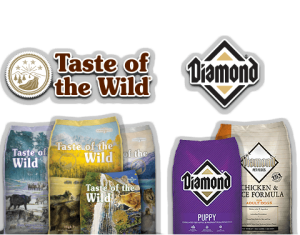

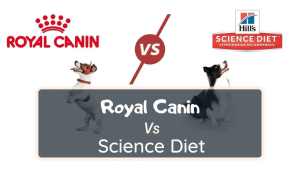
What else do you want to learn?









